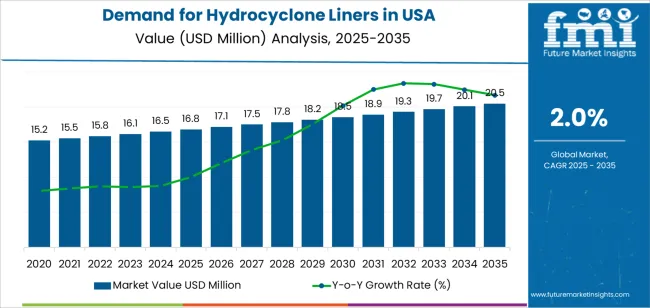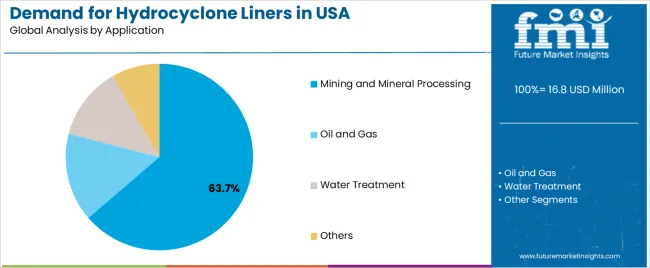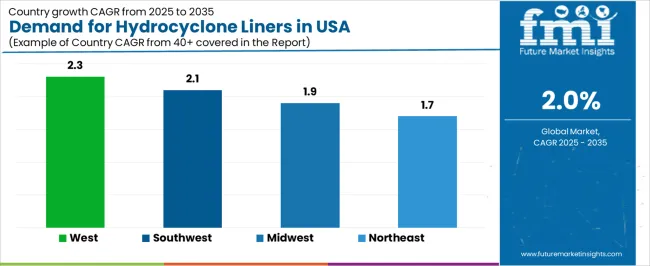Demand for hydrocyclone liners in USA is set to increase from USD 16.8 million in 2025 to USD 20.5 million by 2035, growing at a CAGR of 2% and expanding overall sales by around 1.22 times across the ten-year period. Growth remains steady rather than aggressive, driven by ongoing upgrades in mineral processing plants, replacement cycles in operating mines, and a clear focus on improving separation efficiency and equipment reliability. Ceramic liners hold the largest share at 42.3% due to their longer service life in abrasive slurry environments, while rubber and polyurethane liners continue to serve applications where cost sensitivity and impact resistance are prioritized.
Mining and mineral processing account for about two-thirds of total demand, reflecting the widespread use of hydrocyclones in grinding and classification circuits across copper, iron ore, coal, and precious metal operations. The West region leads demand due to the concentration of large-scale mining sites and established processing infrastructure, followed by the Southwest, where copper and gold processing facilities continue to invest in operational optimization. Between 2025 and 2030, moderate capacity upgrades and liner replacement schedules support incremental growth, while 2030 to 2035 is expected to see more automation in wear monitoring and liner change planning.

Increasing integration of automated processing systems in commercial mining applications and growing adoption of advanced material formulations continue to drive demand. Mining companies are expanding their processing capabilities to address the growing complexity of modern extraction requirements and regulatory specifications, with USA operations leading investments in separation technology systems.
From 2030 to 2035, demand is forecast to grow from USD 18.6 million to USD 20.5 million, adding another USD 1.9 million, which constitutes 51.4% of the overall ten-year expansion. This period is expected to be characterized by expansion of next-generation processing technologies, integration of automated monitoring systems and performance control networks, and development of specialized liner applications across different mining operations. The growing adoption of efficiency optimization principles and enhanced separation requirements, particularly in Western and Southwestern regions, will drive demand for more sophisticated liner systems and specialized material formulations.
Between 2020 and 2025, USA hydrocyclone liner demand experienced steady expansion, driven by increasing operational efficiency requirements in mining sectors and growing awareness of separation technology benefits for cost reduction and performance reliability improvement. The sector developed as mining companies and equipment suppliers, especially in major mineral extraction regions, recognized the need for proven liner solutions and reliable separation management to achieve operational targets while meeting processing excellence expectations and quality compliance requirements. Equipment manufacturers and liner producers began emphasizing proper performance optimization and application integration to maintain operational efficiency and commercial viability.
| Metric | Value |
|---|---|
| USA Hydrocyclone Liners Sales Value (2025) | USD 16.8 million |
| USA Hydrocyclone Liners Forecast Value (2035) | USD 20.5 million |
| USA Hydrocyclone Liners Forecast CAGR (2025-2035) | 2% |
Demand expansion is being supported by the accelerating emphasis on mining operational efficiency and performance optimization nationwide, with USA maintaining its position as a mineral processing technology and equipment innovation leadership region, and the corresponding need for effective separation systems for mineral concentration, particle classification, and processing reliability integration. Modern mining operations rely on hydrocyclone liner technologies to ensure operational competitiveness, regulatory compliance, and optimal pathway achievement toward efficiency-focused processing operations. Advanced processing requirements necessitate comprehensive separation solutions including specialized material formulations, wear resistance capabilities, and performance enhancement infrastructure to address diverse application needs and operational specifications.
The growing emphasis on automation adoption and increasing federal and state-level mining regulations, particularly operational efficiency commitments across USA, are driving demand for separation systems from proven liner suppliers with appropriate material expertise and quality management capabilities. Mining companies and processing operators are increasingly investing in liner technology sourcing and integrated separation management solutions to enhance operational profiles, access efficiency optimization trends, and demonstrate equipment leadership in competitive mining environments. Processing policies and quality compliance requirements are establishing standardized separation pathways that require liner systems and performance assurance, with USA mining operations often pioneering large-scale implementation of advanced separation technologies.
The hydrocyclone liners demand in USA is positioned for consistent expansion, growing from USD 16.8 million in 2025 to USD 20.5 million by 2035, reflecting a 2% CAGR. Rising adoption of advanced separation systems in mining operations, mineral processing facilities, and industrial applications is driving growth as operators seek high-performance liner solutions that maximize equipment life and optimize separation efficiency. Additionally, demand from oil and gas processing and water treatment applications strengthens opportunities for both specialized material formulations and automated installation solutions.
Manufacturers focusing on ceramic liner formulations, automated installation systems, and processing integration capabilities stand to gain from evolving operational standards and customer expectations for separation efficiency, durability, and performance optimization.
Mining operators face increasing demands for efficient separation systems in mineral processing operations. Hydrocyclone liners enable precise particle classification and material separation while extending equipment operational life. Solutions targeting copper mines, iron ore facilities, and precious metals operations can achieve strong adoption rates through cost reduction and processing reliability. Estimated revenue opportunity: USD 2.8--4.2 million.
The expansion in upstream processing facilities and produced water treatment creates robust demand for hydrocyclone liners ensuring efficient separation in petroleum operations. Manufacturers offering separation solutions for oil and gas applications can build relationships with processing operators and equipment suppliers. Estimated revenue opportunity: USD 1.9--2.8 million.
Mining companies are increasingly adopting automated liner replacement systems for consistent separation performance. Collaborations with equipment manufacturers for integrated liner solutions can unlock large-volume supply contracts and long-term partnerships in processing applications. Estimated revenue opportunity: USD 1.6--2.4 million.
Performance requirements and durability standards are driving preference for ceramic liners with superior wear resistance. Suppliers offering high-performance ceramic formulations with enhanced operational life can differentiate offerings and attract performance-focused operators. Estimated revenue opportunity: USD 2.1--3.1 million.
Critical processing applications require liners with exceptional material properties and enhanced separation capabilities. Manufacturers investing in specialized formulation development can secure advantages in serving demanding industrial applications. Estimated revenue opportunity: USD 1.4--2.1 million.
Comprehensive service networks offering installation, maintenance, and performance optimization support create recurring revenue opportunities. Companies building strong technical support capabilities can capture ongoing relationships and enhance customer satisfaction across mining facilities. Estimated revenue opportunity: USD 1.2--1.8 million.
Demand is segmented by type, application, and region. By type, sales are divided into ceramic, rubber, polyurethane, and other material formulations. In terms of application, sales are segmented into mining and mineral processing, oil and gas, water treatment, and others. Regionally, demand is divided into West, Southwest, Midwest, and Northeast, with West representing a key growth and innovation hub for hydrocyclone liner technologies.

The ceramic segment is projected to account for 42.3% of USA hydrocyclone liner demand in 2025, making it the leading type category across the sector. This dominance reflects the superior wear resistance and operational durability of ceramic liner systems for existing mining facilities and processing applications where separation efficiency is optimized through high-performance material properties. In USA, where substantial mining infrastructure requires separation system integration without complete equipment replacement, ceramic systems provide practical pathways for performance enhancement while maintaining operational continuity. Continuous innovations are improving wear resistance, chemical compatibility characteristics, and installation parameters, enabling operators to achieve high performance standards while minimizing maintenance requirements. The segment's strong position is reinforced by the extensive existing mining infrastructure requiring liner adoption and growing availability of ceramic liner technology suppliers with proven commercial experience.

Mining and mineral processing applications are expected to represent 63.7% of USA hydrocyclone liner demand in 2025, highlighting the critical importance of separation processes requiring specialized liner solutions. Mining facilities including copper operations, iron ore processing, coal preparation, and precious metals extraction generate consistent demand for liner systems that are technically and economically favorable for mineral separation applications. The segment benefits from liner characteristics that often provide superior wear resistance compared to conventional separation alternatives, reducing operational complexity and costs. Mining operations also access enhanced processing performance through separation system positioning that improve equipment reliability and operational appeal. In USA, where mining operations represent substantial portions of mineral extraction development, separation system deployment requires hydrocyclone liner integration across diverse mining facilities. In Western and Southwestern regions, where mining concentrations are significant, hydrocyclone liner demand is elevated by emphasis on maintaining operational excellence while achieving efficiency optimization integration targets.
USA hydrocyclone liner demand is advancing steadily due to increasing mining operational efficiency and growing recognition of separation technology necessity for processing development, with Western region serving as a key driver of innovation and application development. However, the sector faces challenges including competition from alternative separation technologies, need for specialized installation infrastructure development, and ongoing concerns regarding system integration complexity and cost considerations. Federal mining guidelines and state-level processing initiatives, particularly efficiency programs in Western and Southwestern regions, continue to influence liner technology selection and deployment timelines.
The enhancement of mining facility regulations, gaining particular significance through industry efficiency guidelines and operational campaigns, is enabling liner suppliers to achieve differentiation without prohibitive development costs, providing predictable demand patterns through processing requirements and efficiency preferences. Enhanced operational standards offering substantial opportunities for separation systems and liner applications provide foundational dynamics while allowing suppliers to secure mining agreements and application partnerships. These trends are particularly valuable for first-mover suppliers and premium liner development that require substantial technology investments without immediate cost advantages.
Modern liner suppliers and mining operators are establishing advanced separation networks and centralized liner management facilities that improve operational efficiency through standardization and economies of scale. Integration of automated installation systems, real-time wear monitoring, and coordinated maintenance management enables more efficient liner operation across multiple processing sources. Advanced separation concepts also support next-generation processing applications including specialized mining integration, facility cluster optimization, and regional liner supply networks that optimize system-level economics while enabling comprehensive separation control across mining regions, with USA developments increasingly adopting collaborative liner models to reduce individual operator costs and accelerate deployment.

| Region | CAGR (2025-2035) |
|---|---|
| West | 2.3% |
| Southwest | 2.1% |
| Midwest | 1.9% |
| Northeast | 1.7% |
USA hydrocyclone liners demand is witnessing consistent growth, supported by rising mining operational efficiency, expanding separation requirements, and the deployment of advanced liner technologies across regions. West leads the nation with a 2.3% CAGR, reflecting progressive mining trends, substantial mineral processing innovation, and early adoption of premium separation systems. Southwest follows with a 2.1% CAGR, driven by extensive mining infrastructure, favorable operational demographics, and concentration of processing facilities that enhance application development. Midwest grows at 1.9%, as facility modernization and operational efficiency opportunities increasingly drive liner deployment. Northeast demonstrates growth at 1.7%, supported by expanding industrial facilities and regional processing initiatives.
Demand for hydrocyclone liners in West is projected to exhibit exceptional growth with a CAGR of 2.3% through 2035, driven by progressive mining preferences, substantial processing development creating premium liner opportunities, and concentration of innovation across California, Nevada, and surrounding states. As the dominant region with extensive mining infrastructure and efficiency-focused operational policies, West's emphasis on comprehensive processing excellence and equipment leadership is creating significant demand for advanced hydrocyclone liner systems with proven performance and reliable application potential. Major mining companies and liner suppliers are establishing comprehensive separation development programs to support processing innovation and premium liner deployment across diverse applications.
Demand for hydrocyclone liners in Southwest is expanding at a CAGR of 2.1%, supported by extensive mining facilities including copper operations, precious metals extraction, and processing establishments generating concentrated demand favorable for separation systems. The region's operational characteristics, featuring substantial mining operations and processing requirements ideal for liner integration, provide natural advantages. Mining industry expertise concentrated in Arizona, New Mexico, and regional processing corridors facilitates application development and operational management. Liner suppliers and manufacturers are implementing comprehensive separation strategies to serve expanding efficiency-focused requirements throughout Southwest.
Demand for hydrocyclone liners in Midwest is growing at a CAGR of 1.9%, driven by substantial industrial facilities from mining operations, materials processing, and regional manufacturing requiring separation pathways. The region's industrial base, supporting critical processing operations, is increasingly adopting liner technologies to maintain competitiveness while meeting efficiency expectations. Manufacturers and liner suppliers are investing in separation integration systems and regional supply infrastructure to address growing liner management requirements.
Demand for hydrocyclone liners in Northeast is advancing at a CAGR of 1.7%, supported by expanding industrial facilities, regional processing development including specialized applications, and growing emphasis on separation solutions across the region. Industrial modernization and processing facility expansion are driving consideration of liner systems as operational enhancement pathways. Industrial companies and liner suppliers are developing regional capabilities to support emerging liner deployment requirements.

USA hydrocyclone liner demand is defined by competition among specialized material manufacturers, mining equipment companies, and separation technology providers, with major industrial liner corporations maintaining significant influence through supply chain resources and technology development capabilities. Companies are investing in liner technology advancement, supply chain optimization, distribution network structures, and comprehensive application services to deliver effective, reliable, and scalable separation solutions across USA mining and industrial applications. Strategic partnerships, technology infrastructure development, and first-mover application execution are central to strengthening competitive positioning and presence across mining, oil and gas, and industrial processing applications.
International Syalons, internationally recognized ceramic leader, leads with 28% share, offering comprehensive hydrocyclone liner supply including manufacturing, technology, and distribution services with focus on mining applications, performance reliability, and cost optimization across USA operations. Morgan Advanced Materials, operating with extensive USA distribution, provides integrated separation solutions leveraging material expertise, quality assurance development, and precision manufacturing capabilities.
Blasch delivers full-service hydrocyclone liner processing including ceramic technology, performance testing, and supply management serving USA and international mining projects. Tega Industries emphasizes comprehensive mining solutions with integrated liner, equipment support, and distribution capabilities leveraging mining sector expertise. Multotec offers hydrocyclone liner application development and quality assurance operations for mining and processing applications across USA operations.
| Item | Value |
|---|---|
| Quantitative Units | USD 20.5 million |
| Type | Ceramic, Rubber, Polyurethane, Other Material Formulations |
| Application | Mining and Mineral Processing, Oil and Gas, Water Treatment, Others |
| Regions Covered | West, Southwest, Midwest, Northeast |
| Key Companies Profiled | International Syalons, Morgan Advanced Materials, Blasch, Tega Industries, Multotec, GTEK MINING, Iracore, SHANVIM, Matec Solutions, Swagath Urethane |
| Additional Attributes | Sales by type and application segment, regional demand trends across West, Southwest, Midwest, and Northeast, competitive landscape with established material suppliers and specialized liner manufacturers, mining operator preferences for ceramic versus rubber technologies, integration with processing efficiency programs and separation policies particularly advanced in Western region |
The global demand for hydrocyclone liners in usa is estimated to be valued at USD 16.8 million in 2025.
The market size for the demand for hydrocyclone liners in usa is projected to reach USD 20.5 million by 2035.
The demand for hydrocyclone liners in usa is expected to grow at a 2.0% CAGR between 2025 and 2035.
The key product types in demand for hydrocyclone liners in usa are ceramic, rubber, polyurethane and other material formulations.
In terms of application, mining and mineral processing segment to command 63.7% share in the demand for hydrocyclone liners in usa in 2025.






Full Research Suite comprises of:
Market outlook & trends analysis
Interviews & case studies
Strategic recommendations
Vendor profiles & capabilities analysis
5-year forecasts
8 regions and 60+ country-level data splits
Market segment data splits
12 months of continuous data updates
DELIVERED AS:
PDF EXCEL ONLINE
Demand Signal Repository Solutions Market Size and Share Forecast Outlook 2025 to 2035
Demand Side Management Market Size and Share Forecast Outlook 2025 to 2035
Demand Response Market Analysis - Size, Share, and Forecast Outlook 2025 to 2035
North America Shipping Supplies Market Trends – Innovations & Growth 2024-2034
Demand of Kozani Saffron in Greece Analysis - Size, Share & Forecast 2025 to 2035
Demand of No-acid Whey Strained Dairy Processing Concepts in European Union Size and Share Forecast Outlook 2025 to 2035
Demand for Bronte Pistachio in Italy Analysis - Size, Share & Forecast 2025 to 2035
Demand and Trend Analysis of Gaming Monitor in Western Europe Size and Share Forecast Outlook 2025 to 2035
Demand and Trend Analysis of Gaming Monitor in Japan Size and Share Forecast Outlook 2025 to 2035
Demand and Trend Analysis of Gaming Monitor in Korea Size and Share Forecast Outlook 2025 to 2035
Glycine Soja (Soybean) Seed Extract Market Size and Share Forecast Outlook 2025 to 2035
Demand and Trend Analysis of Yeast in Japan - Size, Share, and Forecast Outlook 2025 to 2035
Demand and Trends Analysis of Stevia in Japan Size and Share Forecast Outlook 2025 to 2035
Demand of Pistachio-based desserts & ingredients in France Analysis - Size, Share & Forecast 2025 to 2035
Japan Women’s Intimate Care Market Trends – Growth & Forecast 2024-2034
Western Europe Men’s Skincare Market Analysis – Forecast 2023-2033
Demand and Trend Analysis of Fabric Stain Remover in Korea Size and Share Forecast Outlook 2025 to 2035
Demand and Sales Analysis of Paper Cup in Japan Size and Share Forecast Outlook 2025 to 2035
Demand and Sales Analysis of Paper Cup in Korea Size and Share Forecast Outlook 2025 to 2035
Demand and Sales Analysis of Paper Cup in Western Europe Size and Share Forecast Outlook 2025 to 2035

Thank you!
You will receive an email from our Business Development Manager. Please be sure to check your SPAM/JUNK folder too.
Chat With
MaRIA